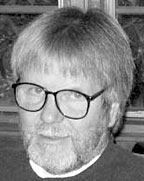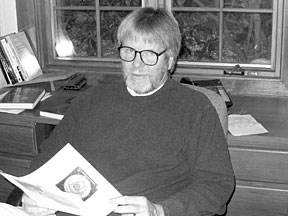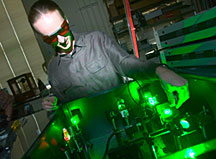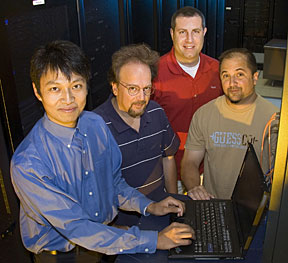Research
Highlights...

|
SNL's Jim Miller
|
|
 |
Number 245 |
October 8, 2007 |
|
What makes quantum dots blink
|
Matthew Pelton of Argonne's Center for Nanoscale Materials adjusts a green laser used to monitor the sporadic blinking of quantum dots. |
In order to learn more about the origins of quantum dot blinking, researchers from DOE's Argonne National Laboratory, the University of Chicago and the California Institute of Technology have developed a method to characterize it on faster time scales than have previously been accessed. Quantum dots are being intensively investigated for applications such as light-emitting diodes, solid-state lighting, lasers, and solar cells. They are also already being applied as fluorescent labels for biological imaging, providing several advantages over the molecular dyes typically used, including a wider range of emitted colors and much greater stability.
[Eleanor Taylor, 630/252-5565,
etaylor@anl.gov] |
|
Dust defeats germ-killing fabrics
While researchers have found many ways to make fabrics that kill germs in the lab, the first field study of germ-killing fabric reveals that the real world is a tougher place. Research performed at DOE's Jefferson Lab shows that contaminants, such as dust and spilled coffee, can coat the surface of a germ-killing fabric and allow germs to thrive. Scientists speculate that germs settle on the dust that collects on top of the fabric; the dust thereby protects germs from the fabrics' germ-killing surface. The researchers are performing additional real-world tests to determine if periodically cleaning the fabric will protect its ability to kill germs.
[Kandice Carter, 757/269-7263,
kcarter@jlab.org] |
|
First-ever model beckons SNS test
|
UT-ORNL Governor's Chair researcher Jeremy Smith is ready for the Spallation Neutron Source to confirm—or contradict—his teams' first-ever atomic-detail computer simulation of protein crystal vibrations. |
An international collaboration directed by a researcher from DOE's Oak Ridge National Laboratory has performed the first-ever atomic-detail computer simulation of how proteins vibrate in a crystal. Jeremy Smith, who leads ORNL's Center for Molecular Biophysics, said experimental testing of the theoretical work will require the capabilities of the Spallation Neutron Source The model predicts the existence and forms of the protein crystal lattice modes."
In doing so it throws out a challenge to next-generation neutron science to finally make the breakthrough and determine the forms and frequencies of the vibrations experimentally," he said. In other words, having overcome their computational hurdle, the lattice dynamics team is now ready for the SNS to test the simulation work and see if what is predicted is really there.
[Bill Cabage, 865/547-4399,
cabagewh@ornl.gov] |
|
Extending the zinc(20) family
Not long ago Ames Laboratory physicists discovered an exciting family of zinc(20) compounds that can be manipulated to take on the properties and behavior of other materials. The highly tunable zinc(20) series, RT2Zn20 (R=rare earth, T=transition metal, Zn=zinc), allows for many model compounds by substituting on either the rare-earth site or the transition metal site.
Now, expanding on that work, the research team has placed ytterbium, Yb, on the rare-earth site, making a half dozen YbT2Zn20 compounds. By putting ytterbium on the rare-earth site in the RT2Zn20 series, the group was able to make compounds that gradually lose their local moment magnetism at low temperatures.
[Saren Johnston, 515-294-3474,
sarenj@ameslab.gov]
|
|
|
Colleagues honor Sandia's Jim Miller with Festschrift issue
 |
Jim Miller |
The Journal of Physical Chemistry recently afforded a rare honor to Jim Miller of DOE's Sandia National Laboratories, publishing a Festschrift issue comprising a collection of articles submitted by combustion chemists to honor his long and productive career.
He called it a highlight of his career, along with winning the Bernard Lewis Gold Medal from the Combustion Institute last year.
A Festschrift — German for celebration publication — is a book honoring a respected academic, usually in honor of an anniversary, retirement, or notable achievement.
“Jim is an intellectual leader and a guiding force for Sandia's energy science program and the Combustion Research Facility,” says Terry Michalske, director of Sandia's Biological and Energy Sciences Center . “His Festschrift is a fitting recognition of his contributions to the international scientific community.”
The introduction to the issue noted that “it is difficult to overestimate the impact that Jim Miller's work has had on the combustion community. But because of the rigor and detail of his chemistry contributions, his remarkable influence spreads beyond the sphere of combustion to the heart of fundamental gas-phase chemical reaction theory.”
After earning a BS in engineering from the University of Cincinnati and a MEng and PhD from Cornell, Miller began working at Sandia in the spring of 1974 and helped open the Combustion Research Facility at Sandia's California lab in 1980. Especially notable among the many achievements in his career was the development of CHEMKIN™, the de facto standard software for modeling chemical kinetics in combustion.
Miller is working currently with former Sandian Stephen Klippenstein of Argonne National Laboratory to develop and implement a theoretical apparatus for studying chemical reactions involving multiple, interconnected potential wells. Such reactions are of paramount importance in the formation of aromatic compounds, polycyclic aromatic compounds (PAH), and soot in flames of aliphatic (non-cyclic) fuels.
Submitted by DOE's
Sandia National Laboratories
|
|





